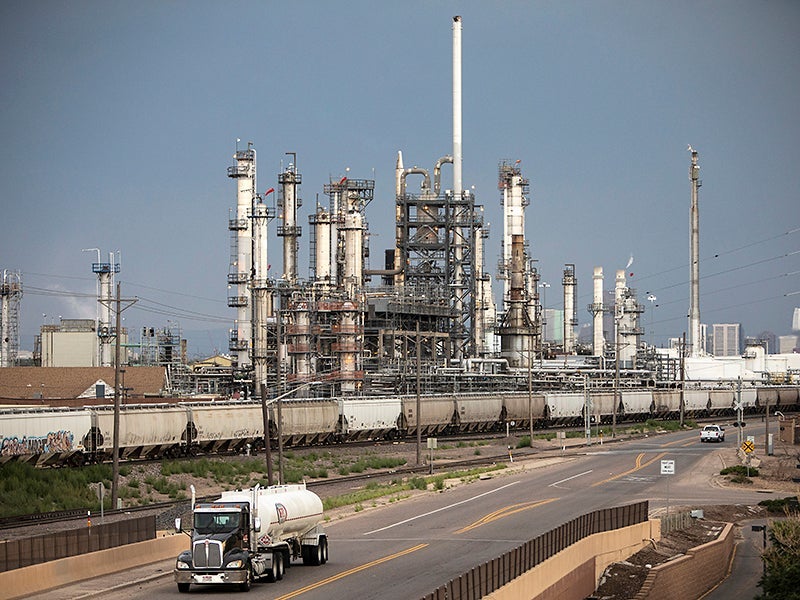Colorado's Suncor Refinery is Fighting a Plan to Monitor its Toxic Pollution
Suncor filed a suit against the state to block fenceline monitoring requirements for its refinery, but community and environmental groups quickly moved to intervene and ensure they remain in place
Communities have a right to know about exposures to toxic pollution that could affect their health. That’s why Earthjustice and our partners are fighting to protect critical steps the state of Colorado has taken to ensure transparency around toxic emissions. Beginning in 2023, the Suncor refinery in North Denver will be required to operate a new fenceline monitoring system to provide better data about toxic air emissions in real-time. In September, Suncor filed suit against the state to block these requirements, but community and environmental groups quickly moved to intervene and ensure they remain in place.
Suncor is an immense refinery located less than a half mile from residential homes, yet it routinely spews hazardous pollution into the air. After an operational issue in 2019, a yellow dust blanketed the surrounding region and schools were forced to shelter in place. The refinery has repeatedly failed to comply with clean air laws, including by exceeding emissions limits in its permit for harmful air toxics.
Those most affected by Suncor’s toxic emissions include low-income families and people of color who—because of historic environmental racism—have disproportionately faced the cumulative impacts of living in a pollution hot spot. Residents living in Commerce City and the neighboring Globeville and Elyria-Swansea communities, in particular, experience disproportionate rates of cancer, diabetes, and asthma as well as reduced life expectancy.
Suncor’s new monitoring system is a result of the work of Earthjustice, our partner organizations, and community members to draft and support the passage of HB21-1189 last year. The legislation directs the Suncor refinery to install continuous air monitors along the facility’s perimeter or “fenceline”—where pollution leaves the refinery’s property and spreads into neighboring communities where people live, work and play.
Continuous fenceline monitoring of toxic emissions at facilities like Suncor provides numerous benefits to surrounding communities. It helps to differentiate between the facility’s emissions and other pollution sources, enables rapid detection of hazardous emission spikes that may pose a risk to health, and can spur prompt notification to neighboring residents. Fenceline monitoring is also a critical tool to enable facility operators to quickly identify and address leaks.
Processing crude oil at refineries causes emissions of many air toxics that put communities living over the fence at risk. The Suncor refinery emits a range of hazardous pollutants like hydrogen cyanide; benzene; toluene; xylene; ethylene; hydrogen sulfide; 1,3 butadiene; and ammonia.
The EPA has designated 188 different pollutants as air toxics known to cause cancer or other serious health impacts. However, federal regulations currently require that refineries conduct fenceline monitoring of just one air toxic: benzene. This benzene fenceline monitoring requirement relies on monitoring methods that estimate an average concentration by collecting air over a two-week span of time, which can hide short-term spikes in toxic pollution and delay data delivery.
Building on this federal requirement and following the lead of air regulators in California, HB21-1189 required that the refinery be fully enclosed by a more protective type of monitoring technology known as optical remote sensing, which uses a beam of light to continuously measure concentrations of air toxics along the path of the beam. This monitoring technology provides greater coverage to detect high-concentration plumes, can release data in quick 5-minute increments, and can measure a wide range of pollutants simultaneously.
Critically, Suncor’s new fenceline monitoring system will also enable early notification whenever the refinery’s emissions pose potential health risks to nearby communities. As required by the legislation, Suncor must provide emergency notification to surrounding residents via call or text alert whenever the refinery’s toxic emissions reach levels that pose a risk to health. The refinery must also increase transparency by making monitoring data available on a public website as soon as possible.
HB 21-1189 also required many opportunities for community engagement throughout the development of Suncor’s real time fenceline monitoring plan. Earlier this year, the refinery submitted an initial draft of its plan, which did not meet the requirements of the law. The plan proposed to monitor intermittently instead of continuously, proposed high community notification thresholds that were not protective of public health and aimed to monitor only three air toxics.
In response to community engagement and public comments calling for a stronger plan, Colorado air regulators used their authority to require significant improvements to Suncor’s plan—including lowering the levels of pollution necessary to trigger emergency notifications, ensuring that the monitors operate continuously, and requiring monitoring and reporting of eleven additional air toxics emitted by the refinery. Now, rather than increasing transparency and protections for the surrounding community, Suncor has sued the state of Colorado to defend its profits and ability to pollute.
GreenLatinos, the Elyria-Swansea Neighborhood Association, Healthy Air and Water Colorado, Womxn from the Mountain, Conservation Colorado, and Sierra Club are intervening to defend the Air Pollution Control Division’s (APCD) fenceline monitoring order and will be represented by Earthjustice. The intervention seeks to protect both the strengthened monitoring plan for Suncor and the Fenceline Monitoring Law itself. Suncor’s suit hopes to eliminate improvements made by APCD to the monitoring plan and substantially narrow APCD’s authority under the Fenceline Monitoring Law.
While Colorado has taken significant strides to address monitoring and transparency around Suncor’s air pollution, ultimately additional action is required to protect the communities most vulnerable to air toxics. Monitoring is a critical piece of the puzzle, but Suncor should not be able to repeatedly put public health at risk with its pollution. In the refinery’s air permit renewals, APCD must take the strongest possible actions to protect surrounding communities.
Earthjustice’s Rocky Mountain office protects the region’s iconic public lands, wildlife species, and precious water resources; defends Tribes and disparately impacted communities fighting to live in a healthy environment; and works to accelerate the region’s transition to 100% clean energy.
